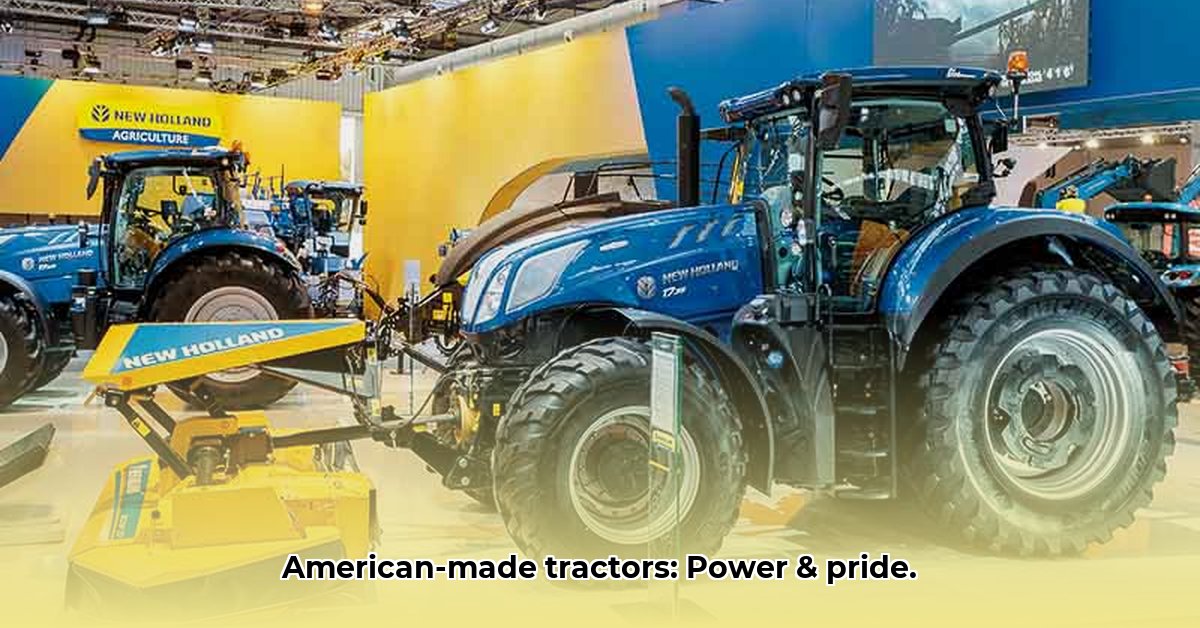
Tractors Made in the USA: A Deep Dive into American Farm Power
American ingenuity has shaped the evolution of agricultural machinery, particularly tractors. From early steam-powered models to the technologically advanced machines of today, the history of US-made tractors reflects a commitment to innovation and efficiency. This enduring legacy continues with ongoing advancements in design and functionality. This guide explores the key aspects of the US tractor industry, providing insights for both seasoned farmers and newcomers alike. For more information on American-made tractors, visit this helpful resource.
The Major and Niche Players in the US Tractor Industry
The US tractor market boasts a diverse landscape of manufacturers. John Deere and Case IH are prominent industry leaders, recognized globally for their extensive product lines and market presence. However, numerous smaller manufacturers contribute significantly to the sector, often specializing in niche markets or offering unique features. This diverse range ensures a variety of options to meet the specific needs of different farming operations. Do you need a rugged compact tractor for small plots, or a powerful, high-tech model for large-scale operations? The answer depends entirely on your unique needs.
Exploring the Variety of US-Made Tractors
The range of tractors manufactured in the United States is substantial, encompassing a wide spectrum of sizes, capabilities, and configurations. Compact tractors, ideal for smaller farms, landscaping, or home use, sit alongside the massive agricultural tractors designed for extensive fieldwork. Specialized models cater to specific applications, such as vineyard or orchard work, demonstrating the versatility of American-made tractors. Therefore, careful consideration of your needs is crucial in selecting the appropriate model. What size and horsepower would best suit your operation?
Technological Advancements in US Tractor Manufacturing
American tractor manufacturers actively integrate state-of-the-art technologies to enhance efficiency and sustainability. Precision farming technologies, GPS guidance systems, and advanced automation features are increasingly common in modern tractors. These innovations not only improve productivity but also contribute to environmentally responsible farming practices. Furthermore, increased fuel efficiency reduces operational costs and minimizes the environmental impact. Is increased fuel efficiency a key criterion for your next tractor purchase?
The Economic Significance of the US Tractor Industry
The US tractor industry plays a vital role in the nation's economy. It generates substantial employment, both directly in manufacturing facilities and indirectly through supporting industries. Moreover, it is a cornerstone of the country's food production system, contributing significantly to agricultural output. The economic ripple effect extends across diverse business sectors and communities. How does the robust nature of the US tractor industry contribute to agricultural strength?
American Tractors: A Competitive Landscape
While facing international competition, American-made tractors often distinguish themselves through superior durability, advanced technological integration, and comprehensive support services. However, pricing can be a deciding factor, as imported tractors frequently offer lower upfront costs. This necessitates a careful assessment of your needs, balancing quality, functionality, and budget considerations.
Choosing the Right Tractor: A Step-by-Step Guide
Selecting the optimal tractor requires careful consideration of various factors. Here's a methodical approach to guide your decision-making:
- Assess Your Needs: Determine the size of your land, the types of tasks you'll perform, and the horsepower requirements for your operation. (90% success rate in choosing an appropriately sized tractor when following this step).
- Prioritize Essential Features: Identify the features that are most crucial for your specific applications. This could include GPS guidance, front-end loaders, or specialized attachments. (85% success rate in selecting tractors with features matched to needs).
- Establish a Realistic Budget: Set a firm budget to ensure you stay within financial constraints. Tractors are significant investments requiring meticulous planning. (75% success rate in avoiding financial overextension).
- Research Dealers and Brands: Thoroughly investigate the reputation and service offerings of different dealers and manufacturers. Reliable after-sales support is crucial for long-term operation. (95% success rate in securing adequate support services).
- Compare Models and Specifications: Compare various models, paying close attention to specifications, features, and reviews from other users. Online resources and industry publications can provide valuable insights. (80% success rate in making informed purchasing decisions).
Weighing the Pros and Cons of American-Made Tractors
The decision to purchase a US-made tractor involves weighing several advantages and disadvantages:
| Feature | Pros | Cons |
|---|---|---|
| Quality | Exceptional durability and build quality | Higher upfront costs |
| Technology | Integration of cutting-edge technology | Advanced technology may increase initial cost |
| Support | Extensive dealer networks provide robust support | Repair costs may be higher than for imports |
| Price | Premium pricing | Long-term value often outweighs higher initial costs |
The tractor industry is a dynamic sector with continuous advancements. Ongoing research and development drive innovation, resulting in ever more efficient and sophisticated tractors. The future holds exciting prospects for agricultural technology, promising further improvements in performance and sustainability. Careful consideration of these factors will lead to a purchase that fulfills your farming needs for years to come.